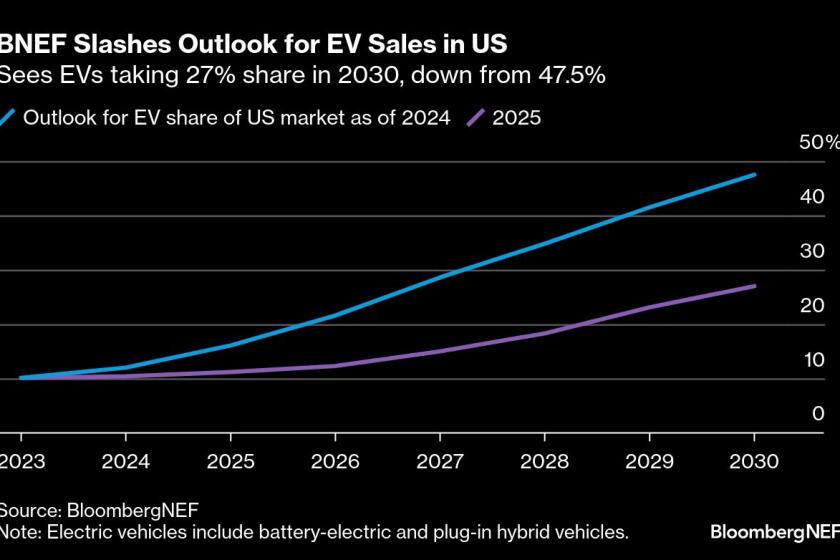California considers requiring motorcycle smog checks
- Share via
Cars do it. Trucks do it. And now the state of California may require motorcycles to do it, too.
Biennial smog checks would be required for motorcycles manufactured in the 2000 model year and later under a bill making its way through the California Legislature.
Introduced in the Senate in late February, SB 435 targets bikes with illegally modified exhaust systems and would go into effect in 2012 if passed and signed by Gov. Arnold Schwarzenegger, an avid motorcyclist.
The measure has won support from health and environmental groups that say the move is critical to reducing the state’s smog pollution but has angered motorcycle-rights groups, dealers and manufacturers, which say it’s bad for business and an infringement of riders’ freedoms.
Motorcycles account for 3.6% of registered vehicles in the state and make up just 0.8% of vehicle-miles traveled, yet account for 10% of passenger vehicles’ smog-forming emissions, according to the California Air Resources Board, which backs the measure. Although fuel-efficient bikes emit significantly less carbon dioxide per mile, the ARB says they are, on average, 14 times more polluting per mile when it comes to emissions of oxides of nitrogen and hydrocarbons -- smog-forming pollutants that have been shown to trigger asthma attacks and worsen respiratory and cardiac illnesses.
The ARB estimates that 5.2 tons of pollutants would be prevented from entering the atmosphere daily if motorcycle smog checks become law.
“Five tons of smog out of 5,691 tons emitted daily from all statewide sources is so minuscule,” said John Paliwoda, executive director of the California Motorcycle Dealers Assn. in Lake Elsinore. “Our feeling is that fewer people will want to buy motorcycles if they’d have to go through a smog check where no smog check is required right now.”
Already, the industry is aching from the freezing of consumer credit and plummeting personal wealth, which have led to a 30.5% decline in new sales for the first quarter of 2009 over the same period last year, according to the Motorcycle Industry Council.
But the ARB says every emission source is fair game in its effort to corral pollutants linked to health problems and climate change.
“It’s so difficult to find new sources of emissions reductions, particularly for L.A.,” said Tom Cackette, the ARB’s deputy director. “Some people think motorcycles look small, and percentage-wise they are tiny, but so is everything else that’s available for emissions reductions.”
California’s existing smog check programs already stop 400 tons of smog-forming pollutants daily, primarily from light-duty cars, trucks and SUVs; but the state must, by 2023, come up with several hundred more tons of pollution savings per day to meet federal clean air requirements. The state also is committed to reducing greenhouse gases.
If motorcycle smog checks become law, the vehicles would join light-duty diesel trucks, which will be subject to smog checks beginning next year, and, potentially, older vehicles. A tougher measure, AB 859, is also working its way through the Legislature. It would require smog checks every year, rather than every other year.
In pursuing bikes of 280 cc and above made in the 2000 model year and beyond, SB 435 attempts to home in on the size of motorcycle more likely to have a modified exhaust system, and an era of bikes equipped with catalytic converters. Motorcycles that employ catalytic converters are more reliant on them to reduce emissions and are at greater risk of becoming gross polluters when those systems are removed.
It’s these gross polluters that SB 435 is after.
Whether for improved performance, a different sound or a custom look, 38% of on-road motorcycle owners replace or modify their exhaust systems, according to the Motorcycle Industry Council’s 2008 Owner Survey. Cruisers are the most common type of bike with a modified exhaust, followed by sport bikes, touring models and competition dirt bikes.
But a 2008 study of aftermarket activity by the ARB found that 85% of bikes 280 cc and larger had modified exhausts. “Most” of those, said Cackette, were illegal.
Not all modified exhausts are illegal; some comply with the emissions requirements that govern what makes and models can be sold in the state. But many modified exhausts remove the bikes’ catalytic converters, causing them to emit twice the legal limit of hydrocarbons and oxides of nitrogen.
“Motorcyclists perhaps don’t realize that those catalytic converters are absolutely critical to improving our air quality,” said state Sen. Fran Pavley (D-Agoura Hills), author of SB 435. “I would like to challenge the motorcycle dealerships to work with us in educating motorcycle riders about the importance of keeping their catalytic converters on their bikes, as well as realizing that since all cars are part of the smog-check program and because we really have air pollution problems in so many parts of California, they need to be part of the solution.”
California was home to nine of the country’s 10 worst cities for smog, according to a recent report by the American Lung Assn., a co-sponsor of SB 435.
“I’m sure that many of these riders have families. They have children, who are especially susceptible to pollution,” said Bonnie Holmes-Gen, senior policy director for the American Lung Assn. of California. “I believe people that ride are concerned about these issues also but maybe just don’t understand how serious the problem is.”
Although stalled in the Senate’s Appropriations Committee, SB 435 is expected on the floor later this month and could be sent to the Assembly in June. A full vote would not be expected before August. Schwarzenegger “owns and rides motorcycles,” but has not taken a position on the bill, said spokesman Aaron McLear.
The California Department of Consumer Affairs would oversee development of the test if the bill passes and has not estimated its cost to motorcycle owners. “It will probably be a simple test -- maybe a visual inspection or a tailpipe test,” Pavley said. “It wouldn’t be as complicated or sophisticated as it is for automobiles.”
Tim Buche, president of the Motorcycle Industry Council in Irvine, said the aims of the test could be circumvented more easily by motorcyclists than by other motorists: Aftermarket exhaust systems, which cost $1,000 to $4,000, can be removed in several hours and reinstalled after the test.
“The whole impact to the consumer of not being able to customize and personalize your motorcycle and tune it as you would like is something we can’t support,” Buche said, “because we know how valued that is by our customers.”
--






